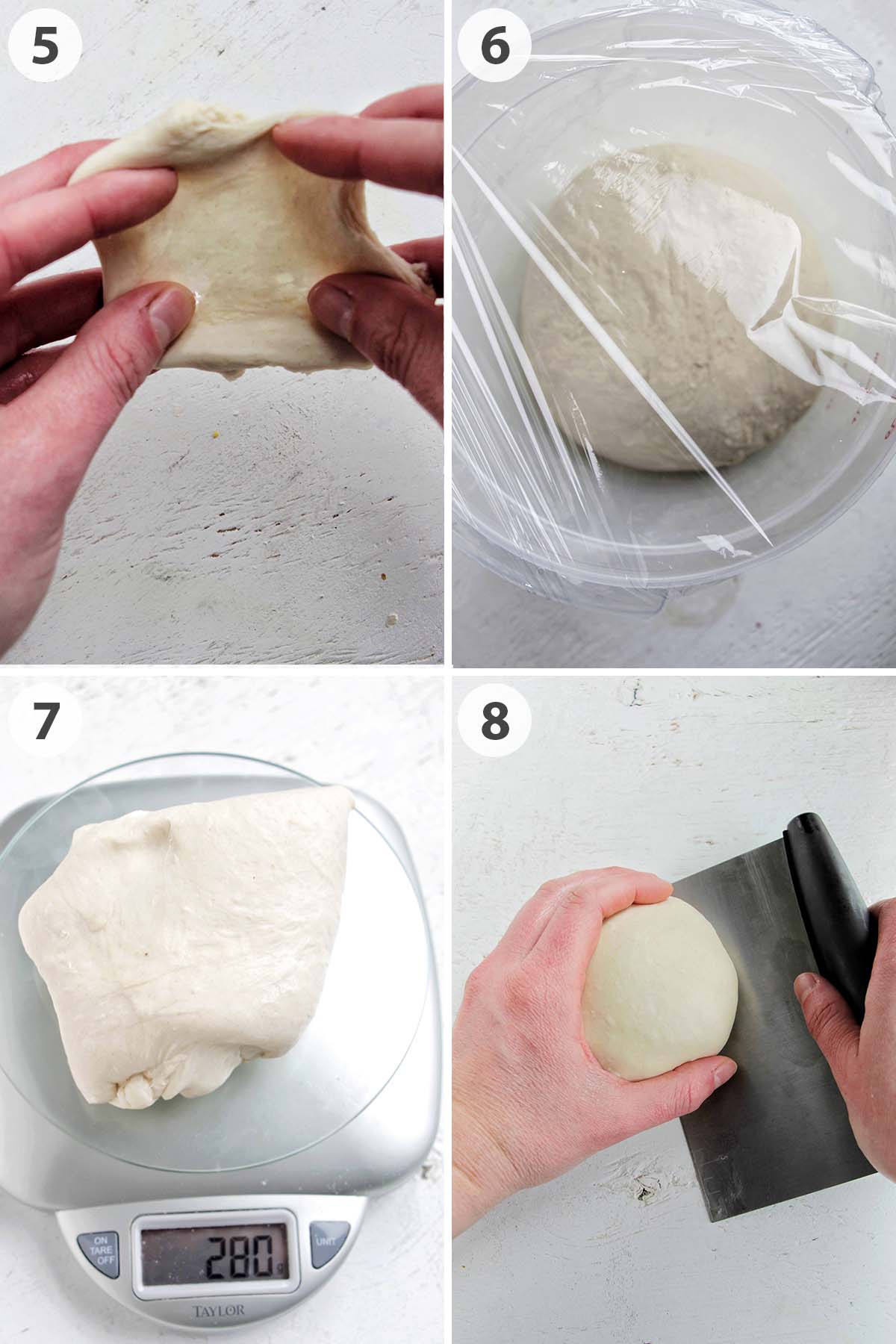Learn how to make an authentic Neapolitan-style pizza dough from a former Italian culinary student. I'm sharing all my tips and tricks for the best authentic Italian pizza Napoletana.

Want To Save This Article?
Enter your email below and we'll send it straight to your inbox. Plus, you'll receive new weekly recipe inspiration.
We would have a pizza party almost every Friday night while I was in culinary school in Italy. To prepare for the pizza party, a few students in our class would be in charge of prepping the dough.
I loved this job partly because I love making dough, and also because it meant I got to practice making pizza Napoletana. This is a thick dough that's from the Campania region in Italy, specifically from the city of Naples.
After helping prep this style of dough for many of our culinary school pizza parties, it's safe to say that I've learned a few tips and tricks to help you make an authentic Neapolitan pizza in your home.
Jump to:
What You'll Learn In This Recipe
- The best ingredients to use for a fresh and delicious Italian Neapolitan pizza.
- Helpful tips for stretching the pizza dough into a perfectly circular shape.
- Cooking instructions for both a home oven and a pizza oven.
Ingredients You Need
Here are a few of the ingredients you'll need. While the truly authentic pizza Napletana requires many stringent regulations, I've adapted them to what is available for home chefs.


- Water: In order for flour to form gluten, it has to be mixed with water. Regular tap water will work just fine for this recipe.
- Fine sea salt: All dough needs salt to add flavor. I prefer fine sea salt (not kosher salt) because it easily distributes throughout the dough.
- Bread flour: This recipe uses bread flour to give the dough a chewy texture. Bread flour has a higher protein content compared to all purpose flour.
- Active dry yeast: Don't use instant yeast for this recipe. Good quality pizza dough ferments (sits) in a cold environment for an extended period of time. Because of this, it's best to use either active dry yeast or fresh yeast (1 gram of dry = 3 grams of fresh).
- Tomato sauce: I love using crushed whole peeled tomatoes (San Marzano tomatoes if you can find them) that I crush by hand and season with a little salt and pepper. However, in a pinch, you can also use jarred tomato sauce.
- Fresh mozzarella cheese: Authentic Neapolitan pizza uses buffalo mozzarella or fior di latte. This is a type of fresh mozzarella that has a lot of moisture in it. Never add this type of cheese to the pizza before cooking the crust (it's considered a sin in Italy).
- Fresh basil: Basil leaves add a beautiful color and fresh bite to the pizza.
- Extra virgin olive oil: This is optional, but a drizzle of olive oil (poured in a spiral motion) over the pizza is the classic finishing touch. Be sure to purchase a high-quality olive oil so you know it has great flavor.
Be sure to check out the recipe card below for a full list of ingredients and exact measurements.
How To Make This Recipe
Here's a step-by-step photo guide for making pizza Napoletana dough, along with some helpful tips.

1. First, add the salt to the water and whisk together.
2. To a stand mixer fitted with a dough hook add the water mixture along with half of the flour. Mix on medium speed until a loose dough forms.
If you don't have a stand mixer, check out the recipe card below for hand-kneading instructions.
3. Add the remaining flour and yeast, then continue mixing on medium speed for 7 minutes.
4. This is what the final mixed dough will look like. It's important to allow the dough to mix for the full time so the proper amount of gluten forms. This is what gives the dough great texture and taste.

5. I always like to check that the dough is fully kneaded by performing the window pane test. To do this test, pinch off a little piece and stretch it out. The dough should stretch thin enough that you can see light through the dough without any tearing. If the dough breaks right away, continue kneading.
6. Roll the dough into a tight ball, then place it in a lightly oiled mixing bowl. Cover with plastic wrap and allow to rest for 1 hour.
7. Now it's time to measure out the individual dough balls. Divide dough into five 9.9 ounces (280 grams) portions using a bench scraper and kitchen scale.
8. Roll each piece of dough into a tight ball. To do this, roll the dough into a rough ball. Then, cup your hand and push the dough ball up against the counter. This will help the bottom of the dough ball seal up. I like to use a bench scraper to help with this.
It's really important to make sure the balls are as round as possible during this stage. A round dough ball makes it easier to stretch out a perfectly circular pizza.

9. Place rolled dough balls into a lightly greased storage container roughly 3 inches (7 cm) apart from each other and cover with plastic wrap. I like using this dough proofing box to store my pizza dough since it perfectly holds 6 balls.
Store the dough in the fridge for 48 hours to develop flavor. I know this sounds like a long waiting period, but this is what gives authentic Italian Neapolitan pizza dough a unique flavor.
10. When you're ready to cook, allow the dough to come to room temperature. Then, on a floured work surface, flatten one dough ball slightly with your hands. Use your fingers to make an indent for the crust.
11. Once the dough is circular, use the outer palm of your hand to continue stretching the dough until it reaches a 13 inch (33 cm) circle with even thickness.
12. To help stretch the dough, hang it on your knuckles and allow gravity to pull it downwards. Don't use your fingers or they could rip a hole in the dough.

13. Top with desired tomato sauce and bake on a pizza stone or in a pizza oven. I love using my Ooni pizza oven because it's compact, affordable, and makes the perfect wood-fired pizza.
15. The cooking time will vary depending on if you use a regular oven or a pizza oven. Bake until the crust is golden brown and the dough is fully cooked on the bottom.

15. Once the pizza comes out of the oven, while it’s still hot, top with fresh mozzarella, basil, and a drizzle of extra virgin olive oil.
I like to do this process with one ball of dough at a time. Once you've finished cooking one pizza, you can prepare the other pizza crusts one by one on a pizza peel.
Expert Tips
- If you want to feel like you're in Italy eating Neapolitan pizza, then start with an appetizer of french fries and drink a beer alongside your pizza. That's how the Italians do it.
- Want to check that your pizza is fully cooked? You should be able to hold up the entire pizza with only 3 fingers to show that the crust is perfectly baked.
- To make a simple pizza sauce, pass whole canned peeled tomatoes through a food mill or blend with an immersion blender. Season the tomato puree with salt and pepper to taste.
Recipe FAQs
If you want flavorful pizza dough, then yes. The cold fermentation in the refrigerator allows the dough to become more flavorful. If you don't have time to wait the full 48 hours, I'd suggest at least allowing the dough to rest overnight.
If you notice the dough is very tough, here are some things to check:
1. Did you fully knead the dough and perform the windowpane test? To test that the dough is ready, pinch off a little piece and stretch it out. The dough should stretch thin enough that you can see light through the dough without any tearing. If the dough breaks right away, continue kneading.
2. Check that your yeast is alive. You can add the yeast, along with a pinch of sugar to water heated to 100°F (38°C). If the yeast does not become foamy after 5 minutes, it's likely dead. You should replace the yeast and make the dough again.
3. Be sure not to overcook the dough in the oven or pizza oven.
Round pizzas come with practice. If you notice your pizza isn't perfectly circular, don't worry, it will still taste delicious. Keep working on your technique for stretching pizza. You have to allow gravity to help you stretch the dough.
Fresh buffalo mozzarella has a high water content. If you add it to the pizza and then cook the cheese, it will release a bunch of water in the oven and cause you to have a watery pizza.
If you want to cook the cheese, opt for shredded low-moisture mozzarella cheese.

Love this recipe? Please leave a 5-star ⭐⭐⭐⭐⭐ rating in the recipe card below. Don't forget to follow along on Instagram, Facebook, YouTube, and Pinterest for more recipes.

Italian Neapolitan Pizza Dough
Equipment
- stand mixer optional
- bench scraper
- kitchen scale
- pizza stone or pizza oven
Ingredients
- 2 ¼ cups water (70°F or 21°C)
- 4 teaspoons fine sea salt
- 7 ¼ cups, plus more for stretching the dough bread flour
- ½ teaspoon active dry yeast
- tomato sauce for serving
- fresh mozzarella for serving
- fresh basil for serving
- extra virgin olive oil for serving
Instructions
- Whisk together water and salt until combined.
- To a stand mixer fitted with a dough hook add the water mixture along with half of the flour. Mix on medium speed until a loose dough forms. Add the remaining flour and yeast, then continue mixing on medium speed for 7 minutes. To test that the dough is ready, pinch off a little piece and stretch it out. The dough should stretch thin enough that you can see light through the dough without any tearing. If the dough breaks right away, continue kneading. If at any time your mixer becomes too hot, take a break or begin hand kneading (see notes below).
- Roll the dough into a tight ball, then place it in a lightly oiled mixing bowl. Cover with plastic wrap and allow to rest for 1 hour.
- Divide dough into five 9.9 ounces (280 grams) portions using a bench scraper. Roll each piece of dough into a tight ball. Place rolled dough balls into a lightly greased storage container roughly 3 inches (7 cm) apart from each other and tightly secure with plastic wrap.
- Store the dough in the refrigerator for 48 hours to develop flavor.
- When you're ready to cook the pizza, remove the dough from the refrigerator and allow it to come to room temperature. Arrange the oven rack to the center of the oven. Place a pizza stone on the rack, then heat oven to 450°F (230°C). Allow the oven and pizza stones to preheat for at least 30 minutes. Alternatively, heat pizza oven to 810°F (432°C).
- Lightly flour a clean work surface. Pour some additional flour into a mixing bowl. Grab a dough ball with a bench scraper, place in the mixing bowl, and cover both sides in flour. Flatten one dough ball slightly with your hands, then use your fingers to make an indent for the crust. Once the dough is circular, use the outer palm of your hand to continue stretching the dough until it reaches a 13 inch (33 cm) circle with even thickness. To help stretch the dough, hang it on your knuckles and allow gravity to pull it downwards.
- Top the dough with tomato sauce and transfer with a pizza peel to a pizza stone dusted with cornmeal and bake for 10 - 14 minutes until the crust is golden brown. If you are using a pizza oven, bake for 60 - 90 seconds, rotating as needed, until the crust is golden brown and the bottom of the dough is fully cooked. Once the pizza comes out of the oven, while it’s still hot, top with fresh mozzarella, basil, and a drizzle of extra virgin olive oil. Repeat with remaining dough balls.






Abby
My family absolutely loved this recipe! It's so hard to find things we all agree on, so I'll definitely be making this again in the future!
Jessica Mode
Abby - I'm so glad you loved it 🙂
lorelei peete
WAS SO DELICIOUS I DREAM OF IT EVERYDAY NOW
Kyle
This dough is sooo good! We used a pizza oven and the dough came out perfectly crispy. Would recommend this to everyone!